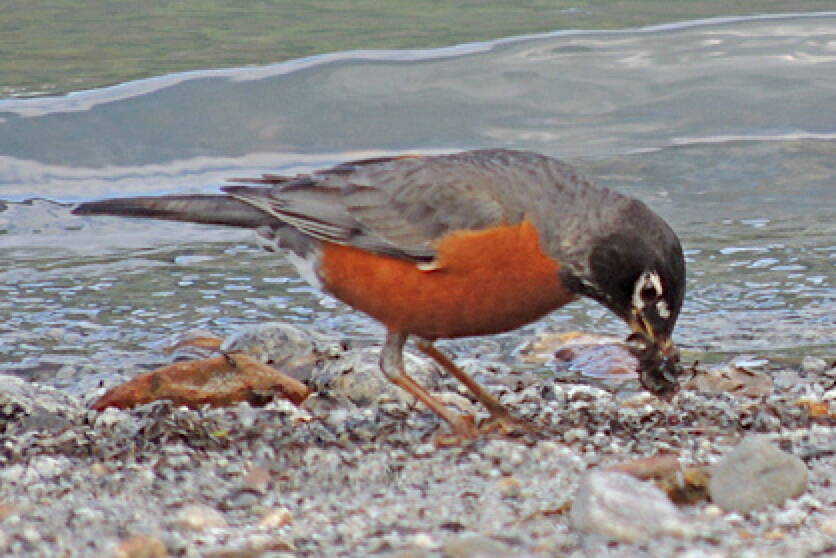Spring comes, quite reliably, but sometimes reluctantly, by fits and starts. Every year we go through a process of counting the increasing hours of daylight, checking the development of leaf buds, and welcoming each sign when we see or hear it. This year, the vernal equinox found ice-covered ponds, many snowy trails, and some freezing night-time temperatures.
But blueberry twigs were turning bright red; fuzzy willow catkins had recently emerged from their bud covers, although their gender was not yet discernible, even when I gently “undressed” them by picking off the almost-shed bud covers. Certainly, the birds knew that spring was happening.
A trumpeter swan at Eagle Beach was surrounded by a squadron of garrulous geese, and swans have been reported in several other places. A varied thrush in my front yard let forth a rusty, out-of-practice song and visited my suet feeder. A dipper near Fish Creek caught a tiny fish and then sang again and again as he foraged for more. A sapsucker, high in the canopy, announced its presence with its characteristic drumming cadence. Juncos trilled cheeringly. Then we heard a song sparrow near Sandy Beach singing, full-voice. And two pairs of kingfishers held a sustained squabble, back and forth over that beach.
On the day of the equinox, a flock of robins flew from the wetlands up into the trees along the dike trail. Not yet ready to sing, they chirped noisily as they waited for me to pass by. One of them lacked the usual reddish breast, showing a front of yellowish feathers instead. Folks that I met on the trail often commented that they found that flock a cheerful sign the spring is really here. In the following days, robins were often seen out there and in some other places too.
Robins are justly welcomed as signs that spring has arrived. But as the season progresses, they often become viewed as just common, garden-variety birds, not unusual and no longer of interest. That may be unfair: they are actually interesting in several ways.
One interesting thing about robins is the characteristic color of their eggs. Variously described as light blue, pale blue, sky blue, turquoise, Nile blue, teal, blue with a touch of green, or just plain blue, and lacking spots, they’ve given the world the term “robin’s egg blue,” which has appeared on the labels of paint cans for certain home-décor companies (along with what colors go well with it, to our eyes). Robins are thus the “poster child” for blue eggs, but they are not the only birds that lay vivid blue eggs. Given the range of names that try to describe egg colors, and the numerous species said to have pale blue eggs (a term used also for robins), it is difficult to discern those that might be most similar to the vivid shade of robins’ eggs. In North America, the eggs of the hermit thrush, varied thrush, gray catbird, and Crissal thrasher come close. Certain breeds of domestic chickens are reported to lay bright blue eggs. Some species of ground-nesting Neotropical tinamous lay vivid blue eggs too. So, clearly, this egg color is not confined to particular taxonomic groups. But it is an unusual color for bird eggs…many of which have some kind of concealing coloration, such as brownish mottling and speckling.
The blue color is the result of a green pigment called biliverdin, a product of the breakdown of the heme molecule in hemoglobin. Although biliverdin may have several functions in living organisms, its function in eggshells is not entirely clear. There seem to be (at least) two ideas that are not mutually exclusive. One is that the vivid blue pigment may both shield the eggs from too much UV radiation without leading to overheating from infrared wavelengths. But then the question is: is this a big problem?? How often do eggs get exposed to light during the incubation period!?
The other suggestion is that the intensity of the blue egg color may somehow inform male robins about the quality of the female parent. The eggs naturally vary slightly in color intensity, and birds should be able to perceive those differences. Researchers replaced natural robin clutches with artificial eggs that were either vivid blue or paler blue, and let the female robins incubate them. At the end of incubation, they removed the artificial eggs and put three young nestlings (from other parents) back into the nest. They then monitored the feeding activity of the attendant males and found that three-day-old chicks from the nests with vivid blue eggs were fed more actively by the males than those from nests with pale eggs or those in un-manipulated control nests.
But that effect didn’t last long: no such effect was found for older nestlings, for which other factors, such as begging intensity, may determine feeding rates. In natural clutches that varied in intensity of the blue color, a similar but weaker trend was observed. It may cost the females some energy to produce and deposit that intense blue pigment, so perhaps females in better condition make better eggs and are more likely to lay those blue eggs. The researchers suggested that the intensity of blue may reflect a (temporary) post-mating signal of the quality of the female or of her investment in the eggs. A few studies of other species with blue-ish eggs provide some support for this idea, but some others found conflicting results.
There may be other ideas floating around out there too. The dramatic color of blue eggs in tinamous and the others still begs for understanding!
• Mary F. Willson is a retired professor of ecology. “On The Trails” appears every Wednesday in the Juneau Empire.

